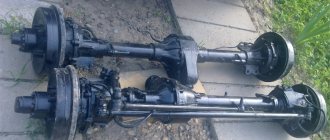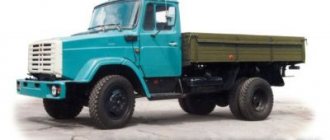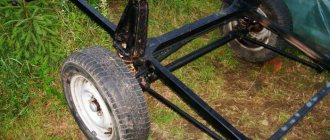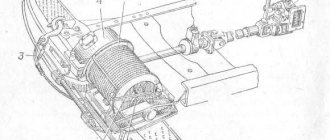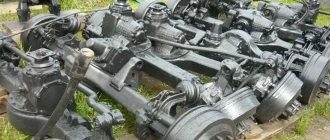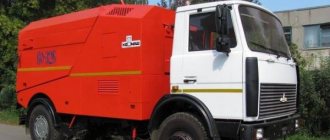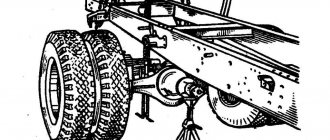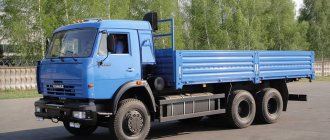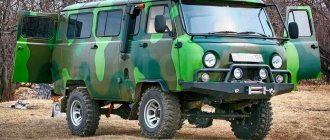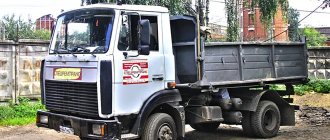Transfer case UAZ-452
The UAZ-452 car consists of drive shafts for drive axles, an intermediate axle, and five gears. All these components are located in a crankcase cast from cast iron. Its connector is perpendicular to the axes of the shafts. The bulk of the parts are in connection with the crankcase cover. When assembling/disassembling the box they are clearly visible. They are convenient to remove or install.
This unit is such that the gears are activated only when the front drive axle is connected. If only the axle is engaged, all the torque removed from the transmission drive shaft will be transmitted to the rear drive shaft. The end of the secondary gear of the gearbox is used as the drive shaft.
Schematic diagram of the UAZ Bukhanka heating system
The embodied schematic diagram of the UAZ Bukhanka heating system attracts great attention from the owners of this car when upgrading the car’s interior. After all, all car owners know that the interior of this off-road car in terms of comfort is very far from its foreign counterparts, although this model was designed from the very beginning for use by intelligence services, and what can you expect for such an inexpensive price.
Suggested options for tuning the UAZ Bukhanka interior
As already indicated, the UAZ 452 car was created to meet the high requirements of special transport for the Ministry of Emergency Situations, military and medical services. True, this fact is not at all considered a statement that the performance of this car can be considered impeccable. That is why, when tuning the interior of the Loaf, not only the heating system is modernized, but also many other parts and components.
First of all, when finalizing the decoration inside the UAZ Bukhanka, most car owners replace standard hard seats with more modern and soft versions, since the main seats can shake out the soul when driving, which is especially typical for off-road driving. Moreover, some craftsmen even integrate chairs with heating and electric drive, for which the existing electrical equipment connection diagram is adjusted.
At another step, attention is paid to soundproofing the interior of the UAZ 452 and fixing the components of the dashboard, but before fastening the components, the heating system of the Bukhanka is modernized, which will be discussed further. In terms of theme, the interior can be lined with leather, the dashboard can be decorated with wood inserts or wood-look details.
Often, various auxiliary accessories appear in the interior of the UAZ Bukhanka, including shelves, glove compartments and ashtrays. The steering wheel is often replaced with a modern imported version with soft leather upholstery or other material.
Of course, there are other options for modifying the interior of this car, which depends on the imagination of the car owner, but one of the main nuances of tuning the interior is still the upgraded circuit of the Bukhanka heating system, since the standard heater simply cannot cope with its immediate tasks.
How Bukhanka's heating system can be modernized
When the schematic diagram of the UAZ Bukhanka heating system is being finalized, the following points must be taken into account.
The heating device of the heater must be located below the level of coolant present in the cooling system, so that this substance is pumped through it much more efficiently and is always present in it. To do this, it is necessary to make the cooling system closed by integrating a weather valve in the cap of the expansion tank. In this case, in the latter, the coolant level must always be higher than the installed heater.
The air needs to be aggravated by a less noisy centrifugal fan, which should be located along the air flow to the heating device. This approach will further reduce the noise parameter.
The air flow through the heating device must pass only due to the pressure generated by the fan, and not using kinetic energy. In this case, the fan nozzle should not blow directly into the radiator honeycomb, since the air will pass unevenly through the heating device.
The temperature of the discharge air should be changed by a damper that mixes cold and hot air flows, and not by a tap. When using a faucet, the temperature will greatly depend on the operating mode of the power unit, and the damper can be used to adjust the ratio of the two air flows.
The driver and passenger of the UAZ 452 will feel more comfortable when a higher temperature develops in the legs and lumbar region, and cooler air should be at face level to eliminate drowsiness. To do this, the heating system circuit must be built in such a way that hot air is forcedly supplied to the feet and glass, and cooler air must flow to the face, which can be done by additional selection of cold air masses between the heating device and the fan, and also using an adjustable mixing damper air flows.
One of the options for upgrading the Bukhanka heating system is usually the following sequence of actions, which consists in integrating a pair of snails onto an ordinary stove body:
- one snail is taken from the Bukhanka salon stove, the body of the second must be taken from MTZ-82, and the fan and motor are installed from another UAZ stove;
- it is necessary to insert a turbine from the Volga into the snail, since the standard one is considered very small and does not inspire confidence;
- then hoses are connected to the volute, for which a plate with a pair of holes is simply made, which is the least difficult solution;
- after this, you need to take traditional sewer expanders with a dimension of 50 * 45, which are attached to the plate. Their fastening is also very ordinary. You need to take plugs from the 50 pipes and make holes in them to form a ring with a side. Then the entire system is placed on the plate;
- To rotate the outlet, you need to put a pair of rubber rings on it, which can be taken from tractor hydraulics. Then the entire system is applied to the cochlea, and as a result it is necessary to obtain a similar performance with the second cochlea. One thing to keep in mind is the integration of diffusers;
- The work ends by fastening the snail to the plate using bolts, rivets and welding, after which the product is painted. It must be remembered that the stove body cannot be removed without draining the antifreeze in advance and without disconnecting the hoses from the heater.
Conclusion
Concluding our discussion of our topic, let us recall that if you invest specific funds and effort into the Loaf, you can get a jeep that is quite convenient for movement. At the same time, the schematic diagram of the UAZ Bukhanka heating system must be modernized, since the base heater is unlikely to live up to its name in the cold season.
Read more:
- Tuning the interior of the UAZ "Loaf"
Every owner of a UAZ Bukhanka car understands that his jeep is very far from its foreign counterparts in terms of comfort in the cabin. Of course, it is much cheaper and was developed in .
Tuning UAZ “Loaf” with your own hands
UAZ-452, popularly known as “loaf” and “tablet”, is an all-wheel drive, two-axle cargo and passenger vehicle, available in flatbed and body versions, with a long history (its production dates back to .
Rear axle drive shaft
What does the UAZ transfer case consist of, what are its features? This shaft is mounted on two ball bearings. To protect the element from axial movements, it is held in place by a rear bearing with a thrust ring and a cover. A gear is attached to the front of the shaft. Its inner crown has slots. The function of this gear is to drive the front drive axle. Internal splines are required to engage direct transmission in the transfer case.
A screw-type gear is also installed on the splines between the bearings. It serves as a drive for the speedometer. The rear part of the shaft is connected to the cardan shaft using a nut with a conical protrusion through a flange. If you tighten this nut, its conical protrusion will bend into one of the grooves that are cut into the threads and stop.
Intermediate shaft
This element is also held in the box by two bearings. A roller one is used as the front one. It is radial type. The cage containing the rollers is pressed into the body. It is hidden by a plug. The inner race is installed directly on the shaft. The second bearing (rear) is held on the intermediate shaft with a nut. The element is equipped with a thrust ring, which serves to fix it, as well as to secure the shaft in the housing. The outer part of the bearing is equipped with a cover. The intermediate shaft is a single part with the reduction gear. It also has splines for installing gears. It allows you to engage the rear drive axle.
UAZ transfer case (“loaf”) - front axle drive shaft device
This gearbox is also equipped with this shaft. It is installed in the mechanism on two supports. The latter are ball bearings. To fix the shaft in the direction of the axis, a rear bearing is attached to it. It is installed in the same way as the one on the intermediate shaft.
The front support is not secured in the box body. The element is clamped to the shaft using the cardan shaft flange. The drive element of the front axle is a single piece together with the gear. The front part has slots. With their help, the shaft is connected to the flange on the cardan shaft.
Technical characteristics of UAZ-452 Loaf
- The mass of cargo transported on the platform is no more than 700 kg
- Weight of cargo transported in the cargo compartment: from 400 kg to 1 ton
- Number of seats: from 2 to 10 Permissible gross weight from 2500 kg to 3000 kg
- Gross towed trailer weight: with brakes 1500 kg, without brakes 750 kg
- Maximum speed: from 100 to 130 km/h
- Fuel consumption (driving at constant speed): from 13 to 18 l/100km
- Maximum incline covered by the vehicle's gross weight: about 30 degrees (58%)
- Fording depth: 0.5 m
- Engine model: UMZ-4213
- Type: 4-stroke, fuel injection
- Number of cylinders: four
- Cylinder arrangement: in-line, vertical
- Displacement: 2.89 liters
- Compression ratio: 8.2
- Maximum torque: 201.0 Nm in the frequency range from 3000-3500 min
Gears
What other elements does the distribution box consist of? The UAZ (“loaf”), the distribution device of which is described in the article, is equipped with gears with straight teeth. The drive has the ability to move along the splines on the secondary shaft of the gearbox. This gear has two rings. One is an involute type spline. They serve to connect direct transmission via the inner drive shaft ring of the rear drive axle. When the driver turns on, this gear will engage with the one on the intermediate shaft.
What else is special about this handout? The UAZ, the transfer case of which we are now considering, is equipped with a gear to engage the front axle of the car. It is positioned in such a way that it can move on splines located on the intermediate shaft. When the front axle is disengaged, the gear and shaft are separated. At the same time, it is in engagement with the drive shaft of the rear axle. This feature greatly facilitates gear shifting and promotes better lubrication. When the intermediate shaft rotates, the gear sprays oil onto all components.
UAZ transfer case
The crankcase, as well as its cover, are connected to the box using studs and nuts. Connection holes are located around the entire perimeter. Their accuracy and compatibility are ensured by two tubular-type pins. Treat the crankcase and its cover together. These parts cannot be exchanged for others from other crankcases. The front part has a precisely machined surface and a flange for mounting the transfer case on the gearbox.
There is a top hole on the crankcase. A thrust glass is installed into it by pressing. The latter rests on the outer part of a double-row angular contact bearing, which is mounted on the drive shaft. There is a hatch in the upper part of the crankcase. It closes with a lid.
The hatch is designed for mounting the power take-off mechanism. On the inclined surface of the crankcase at the top there is a hole for installing control levers, as well as rods for the transfer case control system. The hatch for filling and draining lubricant is closed using conical-type threaded plugs.
Switching mechanism design
So, we looked at how the UAZ transfer case works. The transfer case design is practically no different from the boxes on other cars. Now let's look at what the switching mechanism is.
Thus, the switching system consists of several main components. These are shift fork rods that are secured in the crankcase cover using a locking plate. The device also has forks for engaging the front drive axle and those gears that can move along the rods. The bodies of the plugs have special sockets. Springs and retainer balls are installed here.
While moving along the rod, each of the forks is fixed on it with a special lock. The lower parts have special tabs that fit into the grooves of the gears. There are rectangular recesses on the upper parts. With their help, the fork is connected to the levers to select a gear. What else is special about the distribution box? The UAZ (“loaf”), the gearbox design of which we are considering, is made so that the shift levers are placed in separate covers. The parts are located on the inclined crankcase hatch and are attached to the rod using pins.
The front ends of the rod are equipped with fingers with which they are connected to the rods. In the front part of the cover, the holes for the rods have seals. At the rear they are closed with spherical plugs. There is a small ball between the rods. It functions as a lock. The mechanism prevents the driver from engaging until the front drive axle is engaged. This is how the UAZ distribution box (“loaf”) was made. Its device is not complicated. The mechanism is quite reliable and repairable, according to reviews from car owners.
Modifications of UAZ 452 Loaf
- UAZ-452 - van, main modification
- UAZ-452A is an ambulance, popularly nicknamed the “tablet”. The car could accommodate up to 4 stretchers or six on benches and one accompanying person in both cases. The ambulance did not provide comfort when moving, the suspension remained with the standard model, but was the only ambulance capable of reaching the most remote places.
- UAZ-452AS - ambulance vehicle in northern version
- UAZ-452AE - chassis for installing various equipment
- UAZ-452V - ten-seater minibus with carriage layout
- UAZ-452D - a truck with a double cabin and a wooden body
- UAZ-452G - ambulance, differs from UAZ-452A in capacity
- UAZ-452K - experimental 16-seater three-axle bus, (6x4) (1973).
- UAZ-452P - truck tractor
Useful articles on repairing UAZ Bukhanka Updated UAZ Bukhanka Cargo SGR.
Handout control
You can control the work using levers. These levers in the cockpit are located to the right of the driver. There are only two of them. The upper one is used to turn the front drive axle on and off. This lever only works in two positions. The upper one turns the bridge on, and the lower one turns it off.
The lower one is necessary in order to change gears. It can be set in three positions - the driver selects direct gear, neutral (middle position) and low gear. This is how the transfer case is turned on. UAZ (“loaf”), the design of the box of which we examined, has one more feature. It should be noted that the front axle is intended only for operating the vehicle in difficult conditions. It could be mud, sand, snow or any other situation.
Pros and cons of UAZ Bukhanki
The general pros and cons of UAZs, as well as the details of choosing a new or used UAZ are perfectly described on the UAZbook, and in short, you need a garage, and the ability + desire to twist the nuts yourself: otherwise the car will be quite expensive to maintain.
I would like to draw your attention to the difference between the Bukhanka and other UAZs: the engine in the cabin (the fresh paint simply heated up and stuck to the jackets of the drivers who were ferrying the loaves from Ulyanovsk) + a complete lack of protection for the legs and the driver himself in a head-on collision. These facts must be taken into account when choosing a Loaf.
Reliability In general, you need to understand that the UAZ loaf is the brainchild of the domestic automobile industry. If you immediately accept this fact and do not try to treat the UAZ as a foreign car that does not break down or leak, then communication with the UAZ immediately becomes easier and more honest: the UAZ is a fairly simple, utilitarian car, which was not created for comfort and not for breaking records. maintenance-free operation: the UAZ’s task is to accompany a tank column on the march. Everything else is just an attempt to dress up an army vehicle in civilian guise.
The maintainability of UAZ vehicles often pays for its low reliability and comfort. There is also an opinion that Bukhanki, in comparison with other UAZ models (for example, those currently produced by Hunters and Patriots), are much more technically reliable, since they are manufactured for doctors and the Ministry of Emergency Situations, where the requirements for reliability are much higher than in civilian life .
Passability One big plus is all-wheel drive and a geometric formula that provides cross-country ability, which can only be appreciated by trying - even as a passenger - to cross a forest path broken up by timber trucks or go fishing along a path washed out in the spring to a forest lake.
Maintenance and repair
This is what the UAZ distribution box (“loaf”) is like. Its design and repair are simple, and it is unpretentious in maintenance, as evidenced by reviews from the owners. It is recommended to regularly check the oil level and inspect each fastener. It is also necessary to lubricate the axles of the levers and adjust the front linkages. This box has no other settings.
The transfer case of the UAZ-452 is very popular among fans of off-road vehicles. Reviews about her are only positive. It is extremely easy to repair and maintain, and spare parts can be purchased now.
About the book
: Instructions.
1976 edition. Book format
: pdf file in zip archive
Pages
: 129
Language
: Russian
Size
: 6.5 mb.
Download
: free, without restrictions and passwords
This Operating Instructions for UAZ-452 vehicles is intended for personnel directly related to the use and storage of UAZ-452 vehicles and its modifications. All-terrain vehicles of the UAZ-452 family with front and rear drive axles are designed for use on roads of all classes. The Ulyanovsk Automobile Plant produces cars of the following models:
Vans UAZ-452 and UAZ-452E
intended for the transportation of industrial and food products. The all-metal closed carriage-type body is divided by a partition into the driver's cabin and the cargo compartment. Loading and unloading can be done through the side and rear double doors. The UAZ-452E van differs from a car only in its shielded electrical equipment.
Sanitary vehicles UAZ-452A and UAZ-452AE
are intended for transporting patients and servicing emergency medical centers. They have the same body as a van, with a sanitary compartment separated by a partition. The sanitary compartment has side and rear double doors. Stretchers are admitted through the back door. The UAZ-452AE vehicle has shielded electrical equipment.
Bus UAZ-452V
designed to carry 10 passengers, not including the driver. Passengers board through the side door of the passenger compartment of the body.
Trucks UAZ-452D and UAZ-452DE
are intended for widespread use in the transportation of national economic goods. The driver's cabin is double, all-metal, two-door, closed. The platform is wooden, with three folding sides. The vehicle has shielded electrical equipment.
In order to make full use of all the qualities of the vehicles, it is necessary to comply with all the requirements set out in this Manual. Particularly important are the factory's instructions for running-in, which largely determines the service life of the vehicle.
1. Before preparing the vehicle for operation, the driver and mechanic must fully study this Manual.
2. If the car was in storage, then it is necessary to perform the work specified in the subsection “Removing the car from storage.”
3. For normal engine operation, A-72 or A-76 gasoline is required. When working with leaded gasoline, keep in mind that it is highly toxic and causes poisoning. To distinguish it from regular gasoline, leaded gasoline is colored yellow-orange or blue-green.
4. Be sure to drain water from the cooling system through two taps with the radiator cap removed and the heater tap open.
5. After starting a cold engine, you should not immediately give it high speeds. Do not start driving with a cold engine. The coolant temperature must be maintained within 80-90 degrees Celsius.
6. When driving on dry, hard roads, the front drive axle should be turned off, and when driving for a long time on dry, hard roads, it is recommended to turn off the front wheels. When the front wheels are disabled, the front drive axle cannot be engaged.
7. For better running-in of engine and chassis parts during the first thousand kilometers (during the vehicle’s break-in period), it is necessary to strictly follow all the instructions in the subsection “Break-in of a new car” and, in particular, not to exceed the speeds specified in this subsection.
8. For ease of engine maintenance, the sides of the hood are removable.
9. It is necessary to constantly monitor the water level in the radiator. It should be remembered that when the heater is turned on, the water level in the radiator decreases. Therefore, after filling the heater radiator, it is necessary to add water to the cooling system. You must not allow a lack of water in the upper radiator tank, as this will lead to failure of the water temperature sensor located here.
10. The plant draws the attention of consumers to the need to periodically check external bolt fastenings and tighten them both during the break-in period and during further operation of the vehicle.
The plant is constantly improving the design of its cars, and therefore the latest design changes that do not affect the operating rules; may not be reflected in this edition of the Instructions.
UAZ-31512, UAZ-3741, UAZ-3303, UAZ-2206, UAZ-3909 general information (UAZ since 1985)
Removing the gearbox from vehicles of the UAZ-3741 family
Removal is carried out in the following order: 1. Drain the oil from the gearbox and transfer case. 2. Remove the clutch release fork. 3. Remove the clutch release bearing grease cap and disconnect it from the bearing lubrication hose. 4. Disconnect the shift rods from the shift mechanism and transfer case. 5. Support the engine from below using a jack or other device. 6. Unscrew and disassemble the rear engine mounts. 7. Disconnect the driveshaft flanges. 8. Disconnect the parking brake cable. 9. Disconnect the speedometer flexible shaft. 10. Unscrew the four nuts securing the gearbox to the clutch housing. 11. Move the unit back until the input shaft exits the clutch housing. 12. Lower the unit down.
Install the unit on the car in the reverse order.
Disconnecting the gearbox from the transfer case 1. Place the unit vertically on the parking brake drum. 2. Switch the transfer loin to direct gear. 3. Unscrew the three stud nuts and two bolts securing the gearbox to the transfer case. 4. Lifting the gearbox up, disconnect it from the transfer case. 5. After removing the transmission, the transfer case remains with a gasket, a suspension plate, a second gasket and a thrust ring for the transmission intermediate shaft bearing.
The vehicles produced at the plant in Ulyanovsk are classified as off-road vehicles; it is no coincidence that the package includes a UAZ transfer case. The mechanism is designed to distribute the torsional impulse of the motor to the wheels. The design increases the number of transmission gears and torque when moving off-road.
Initially, UAZ vehicles, including ““, were developed for the needs of the army. That's why the transmission is simple, unpretentious and requires minimal maintenance. Thanks to these qualities, the car appealed to lovers of hunting, fishing, and tourism. In addition, the transport is suitable for transporting goods in the absence of roads.
Transfer case UAZ-452 “Loaf”:
Car engines device, UAZ repair
- UAZ car engines
- Engine markings
- Main modifications and versions of engines
- Design features of engines
- Starting and stopping the engine
- Technical characteristics of engines
- Possible engine malfunctions, their causes and methods of elimination
- UAZ car engines. Supply system
- UAZ car engines. Lubrication system
- UAZ car engines. Gas distribution mechanism
- Engines of Volzhskie Motors OJSC for UAZ and GAZelle vehicles. Device, diagnostics, repair
- Engines of JSC "Volzhskie Motors"
- Three-liter “Volga Motors” - yesterday, today, tomorrow
- Benjamin Dzhepaev about the UMZ-249 engine
- Automotive engine UMZ-249
- Installation of engine 249.10 on UAZ 31519 with portal (military) axles
- Catalog of parts and assembly units of the ZMZ-409 engine
- Engines of Volzhskie Motors OJSC for UAZ and GAZelle vehicles. Device, diagnostics, repair
- Project - GAZ 53 engine for UAZ
- Engines of the ZMZ-406 family
- Engine UMZ-417 (power system)
- Engine UMZ-417 (power system)
- Engine UMZ-417 (gas distribution mechanism)
- Engine UMZ-417 (starting heater)
- Engine UMZ-417 (lubrication system)
- Engine UMZ-417 (Oil filter)
- Installing an injector on a 417 engine
- Engine UMZ-420
- Operating manual for diesel engine ZMZ-5143.10
- Instructions for servicing Andoria diesel engines 4ST90-1 MEA 1602 and 4ST90-1 MEA 1603
- A manual for repairing Andoria engines in three parts: part 1, part 2, part 3.
- Repair of UMZ-421 (balancing)
- Repair of cylinder block 421.1002014 of the UMZ-421 engine
- Experience of Volgovod, part-time master, in engine repair
- Engine installation from ISUZU 4jb1t
- Installing a Toyota Hayes engine
- UAZ-315148 (turbodiesel) - first impressions
- Radiators of JSC "SHAAZ"
- Solex carburetors for the Volga. Efficiency reserves
- Carburetor DAAZ-1111
- Carburetor DAAZ-4178
- Carburetor K-126G
- Maintenance of the K-131 carburetor (for engines mod. 414)
- Carburetor K-151
- Carburetors K-151 - design, repair, adjustment
- Cable gas drive for K-151S carburetor
- The lambda sensor probes the exhaust
- First impressions of the ATE-2 ignition
- Installing a “Volgov” filter (pan) on a 126 carburetor
- Moving the gas tank into the cabin
The device of the UAZ “Bukhanka” transfer case
The UAZ Bukhanka transfer case is a two-stage design without a differential between the axles. The mechanism is also equipped with a neutral message and switchable front wheels. The components are placed in a tray made of cast iron and equipped with a plug. The pallet is attached to the back of the box through the holes of the plates. In addition, the components of the handbrake are also attached here. The main and transition shafts of the box, the drives of the front and rear wheels, are secured by bearings. Between the supports that facilitate the rotation of the shaft, a gear is placed that drives the speed measuring device. The top of the box has an inspection hatch protected by a shutter.
Dymos transfer case for UAZ (finishing):
The control contains two rods with forks attached to a plug. The fork-shaped rods work in tandem with the drive gear and the activation gear for the front pair of wheels. Two control rods are connected to the forks by means of movable pins. There is also a blocking sphere that prevents the activation of low gear when the front wheels are not working.
By activating direct transmission, the UAZ Bukhanka transfer case acts in a similar way so that the main gear moves into the slot of the gear shaft of the rear pair of wheels, transporting the impulse directly. Activating the low gear shifts the main gear so that the impulse is transported to the intermediate shaft and to the gears that drive the axle. Activation of the low stage is only possible after the machine has come to a complete stop.
Transmission of UAZ cars (repair, installation)
- Transmission of UAZ cars
- Possible gearbox malfunctions, their causes and methods of elimination
- Maintenance and operation of the DYMOS gearbox (Korea)
- Catalog of DYMOS gearbox assembly units (Korea)
- Alteration of the UAZ breather
- We repair the gearbox
- How to remove the noise of a UAZ helical transfer case
- Method for dealing with transfer case noise
- UAZ transfer case: dimensions, tolerances and fits
- Drive axles
- Drive axles
- Features of installation 5st. Gearbox produced by Avtodetal-Service
- Installation of the main pair from the Volga to the UAZ bridge
- Adjusting civil axles of a UAZ vehicle
- Installing power steering power steering on a UAZ
- UAZ-469 fine-tuning the brake system
- VUT for UAZ vacuum brake booster
- Clutch
- Installation of VAZ GCS on a UAZ car
- Power steering (power steering)
- UAZ hydraulic booster: description, installation, operation, maintenance
- Power steering for UAZ based on mechanisms from Audi-100
- Power steering from BMW 7 series on UAZ
- Why does the hydraulic booster stop “assisting to the left”?
- Power take-off for UAZ
- UAZ-469 modification of the brake system
- Disc brakes on UAZ Bukhanka on collective farm bridges UAZ
- UAZ car brakes
- Disc brakes for geared military axles UAZ
- Brake fluids
- Hydraulic brake condition indicator
- Modernization of the steering column for UAZ-3909(3741)
- Methodology for reducing fuel consumption of a UAZ 31512 car
- Cable gas drive and pedal from Gazelle
- Recommendations for setting up the Opus N 3 distributor
- Experience in operating a distributor with a Hall sensor
Checking the transfer case
The advantage of the unit that distributes the torque impulse is that the device requires minimal intervention and maintenance. Manipulations consist of monitoring the level and changing the lubricant, inspecting connections for damage. Before working with the box, the product is cleaned. This helps detect hidden cracks and leaks. If such symptoms are detected, they find out what the cause of the phenomenon is. Faulty parts are replaced, as a rule, these are sealing elements and oil seals.
After cleaning and visually inspecting the surface of the transfer case, check the lubricant level in the product. If there is not enough liquid, the substance is added. At the same time, check the lubricant in the gearbox; the value corresponds to the lower edge of the filling hole. If the fluid level in the transfer case is low, but is high in the gearbox, topping up is not necessary, since the total amount of the substance has not changed.
A detailed inspection of the box involves dismantling the product. After washing and air drying, the unit is inspected. The pallet and plugs are checked for cracks and chips. Oil seals and seals are replaced with new ones.
Changing the oil in the UAZ transfer case:
They check that the condition of the working parts on the shafts and splines corresponds to the standard, so that the gear teeth are not worn or chipped. Even if the damage is small, the product must be replaced. Attention is paid to the bearings; abrasions on the ring tracks are not acceptable. They also check separators, spheres, rollers, etc. Gaps, fragments, knocking, uneven movement are a signal to change the product.
The rods and forks become jammed and deformed, the elasticity of the spring elements is lost, and then the products are replaced. In addition, you should pay close attention to switching when the transfer case levers of the UAZ Bukhanka stick and jam. The coupling teeth are checked for damage. The weak link of the differential is the satellite. Small defects force the product to be polished, or in the worst case, replaced.
Causes and troubleshooting
The design of the UAZ gearbox is reliable, trouble-free and durable. However, problems with equipment occur due to errors in use and violation of established regulations.
| Source and symptoms | What to do |
| Exceeding the permissible hum level of a working device | |
| Erasing the gear teeth of the box. | |
| Weak fastening of the transfer case to the box, or reduced fixation of the bearing caps. | Tighten the fasteners, if the symptom recurs, dismantle the product and eliminate the defect. |
| Bearings are worn out. | Replace erased items. |
| Saturation of the working fluid with wear products from the box. | Remove the pan, wash it, change the oil. |
| Incorrect oil used, low fluid filling level. | Change the working fluid, set the desired level. |
| Carrying out repairs to replace gears, without selecting a product to minimize noise. | Check the gears for noise and replace them with the required ones. |
| Switching steps is difficult | |
| Different wheel wear. | Replace with wheels with the same tread and equalize the internal pressure. |
| The joints of the longitudinal projections of the main and the mediator shaft are jammed. | Sand the areas with burrs; if that doesn’t help, change the elements. |
| The drive gear has damage on the teeth of the small ring. The shift fork rod is bent. | Sand the damaged areas, straighten the rod, if that doesn’t help, change the element. |
| The switch rods are stuck on the axle. | Separate the parts, clean the axles and pipes, coat with lubricant, and connect the product again. |
| Spontaneous speed shutdown | |
| Erasing the teeth of the gears of the box. | Replace worn out box items. |
| The box bearings are worn out. | Replace worn box elements. |
| A large gap in the articulation of the shaft and gear. | Select the gear according to the size of the longitudinal protrusions. |
| The transmission is unable to engage because the mechanism is bent or there is damage to the gears and cylinders. | Correct bends, sand damage, or replace parts. |
| Poor functioning of the locking mechanism, loss of elasticity of the spring mechanism, abrasion. | Replace erased items. |
| Leakage of working fluid | |
| Violation of the integrity of the sealing elements of the pan, bearing caps, and the transfer case’s articulation with the gearbox. | Replace sealing elements. |
| Weak fastening of the cover, bearing, pan, joints. | Tighten connections. |
| Violation of the integrity of the shaft seals. | |
| Violation of the integrity of the tray or lid. | Replace the damaged element. |
| The plugs of the switching rods, switching rods, and the plugs of the front bearing of the middle shaft fall out or are broken. | Change the plugs. |
| Bearings are damaged | |
| No, or a small amount of lubricant. | Change or add fluid. |
| Demolition of cages and bearing rings due to abrasive. | Change the elements, dismantle and wash the pan, change the working fluid. |
| Excessive shaft bearing friction. | Disconnect the element, clean the product, and coat it with lubricant before reassembling. |
The distributor needs careful handling and periodic inspection. Often, the reason for the breakdown is trivial driving on wheels with a violation of the pressure regime. Continuous use of the front pair of wheels is not allowed; the product is used as needed. Operation is affected by the use of spare parts that do not meet the required quality.
Repair of UAZ Bukhanka transfer case
Serious repairs to the UAZ transfer case are rarely performed. As a rule, to restore normal operation, adjusting the product and lubricating problem areas is enough. If repairs cannot be avoided, then the operation to return the box to its former functionality is done in strict order.
- Dismantling the transfer case;
- Disassembling the transfer case;
- Fault detection;
- Troubleshooting (replacement, restoration of parts);
- Transfer case assembly;
- Installing the transfer case in place;
- Functionality check and configuration.
Before carrying out work, select the necessary tools; for this, find out the type and type of transfer case. Functionally, repair is the replacement of damaged parts with new ones, for this reason more attention is paid to the rejection stage.
- Oil seals (changed during disassembly, regardless of the degree of wear);
- Gears (parts cannot be repaired due to the loads they experience);
- Forks and splines (elements affect the quality of work and safety);
- Bearings;
- Protective casing (if cracks or chips are detected, the part is replaced).
UAZ transfer case control mechanism:
Heater UAZ "Loaf"
A car is made up of a large number of components. Any of them requires very high attention. Thanks to this, drivers must monitor the condition of their own “iron horse”. The issue of preparing the car for the winter period is very important.
The most important role here is the presence of a well-thought-out heating system. Let's talk about it in the UAZ "Loaf".
This system is important, firstly, for maintaining normal temperature in the cabin, regardless of the time of year, for air ventilation in the middle of the car.
Most “loaf” models are equipped with a very high-power heater “N-1” produced by NAMI.
Design:
The heater includes the following elements:
- Heating device.
- Fan.
- Special device for air distribution.
There are two key operating modes:
- When clean air is supplied.
- When recirculating flows.
The second mode assumes a very high temperature in the cabin. To do this, you need to close the air intake and then open the damper. In the first mode, the actions are performed in the reverse order.
A specialized unit controls the entire system. A tap is used for adjustment. The new design, built on increased circulation of flows and the use of liquid in the heating device, allows you to warm up the interior faster.
It is necessary to remember about glass blowing. Otherwise, this will lead to their covering with ice and fogging. The driver and passengers will feel discomfort.
If moisture penetrates, it is removed through the air intake. A docking device is used here.
Motorists often encounter cases when the heater (stove) does not perform its direct functions and does not heat. What could be the reasons?
- The presence of damage in the channels through which air passes.
- Antifreeze is leaking.
- The system is clogged, resulting in unsatisfactory temperature.
- The faucet on the stove was leaking.
- The valve responsible for protecting the motor burned out.
How to change a used stove with your own hands? What will you need for this? Everything can be done using the following method.
- We drain all the antifreeze and disconnect all wiring.
- Separate the console from the shield. We remove the heating unit, the air intake hatch, remove the seal, and then clean the recesses.
- We try on the air filter, drill holes no larger than 3.2 mm in diameter.
- Apply a large layer of sealant to the installation site. We install the body and mark. We return the filters from the cabin to their place.
- We install a new heater in the cabin, securing it with M-6 studs and nuts. We mark the node, then install the block console. We mark the entire structure with screws.
- Next we connect the control rod and secure it. We connect the pipe sections containing the antifreeze to the unit and mark them with specialized clamps. Then we install blowing channels for the glass.
- To summarize, we connect the electrics, fill the system and check that it does not stop working. If breakdowns occur, you need to check the entire system again.
Summarizing
The heating system of the UAZ Bukhanka car is quite conventional in its design. If its operation is not checked in a timely manner, the owner will ultimately need to spend cash on car service.
